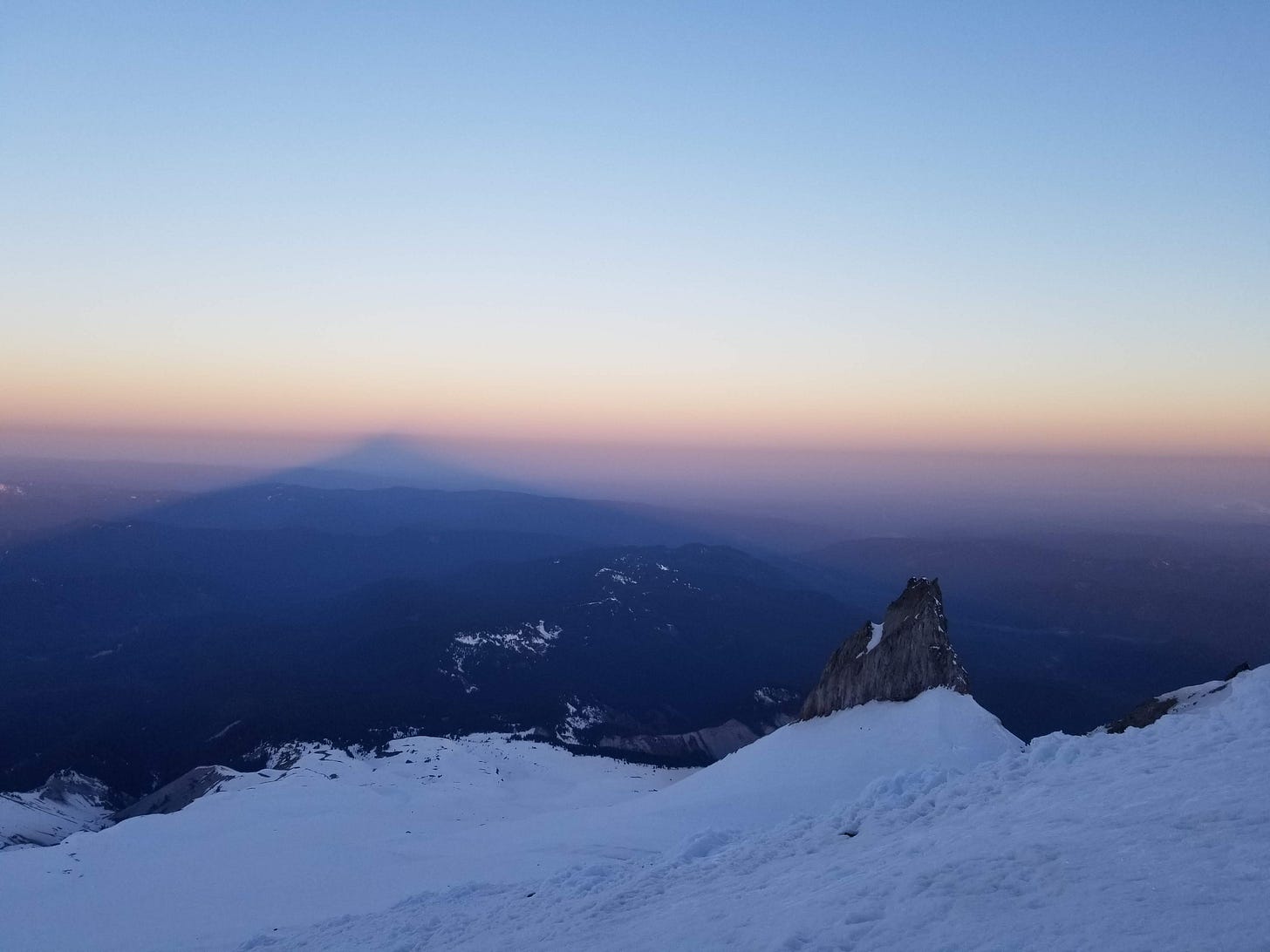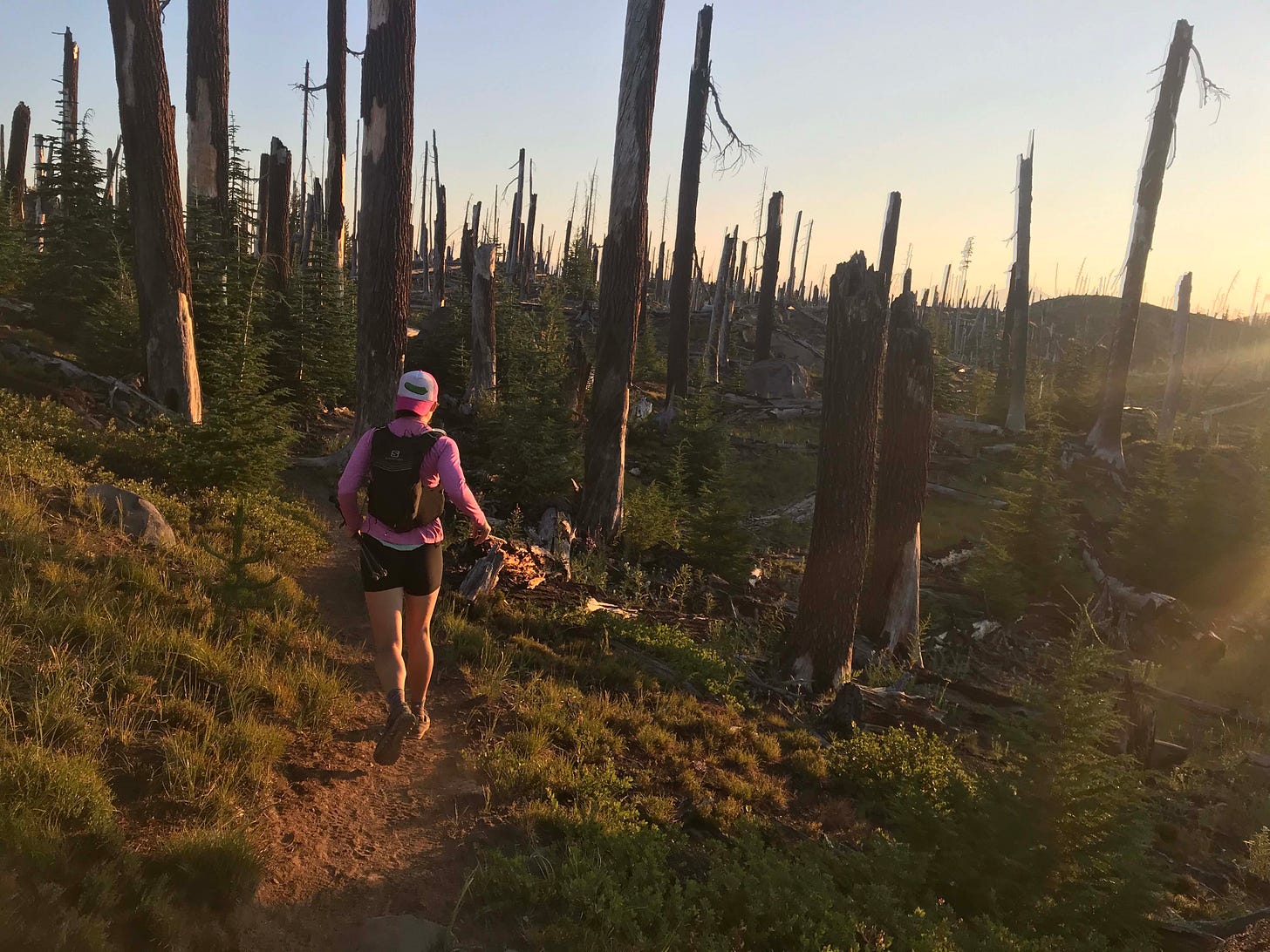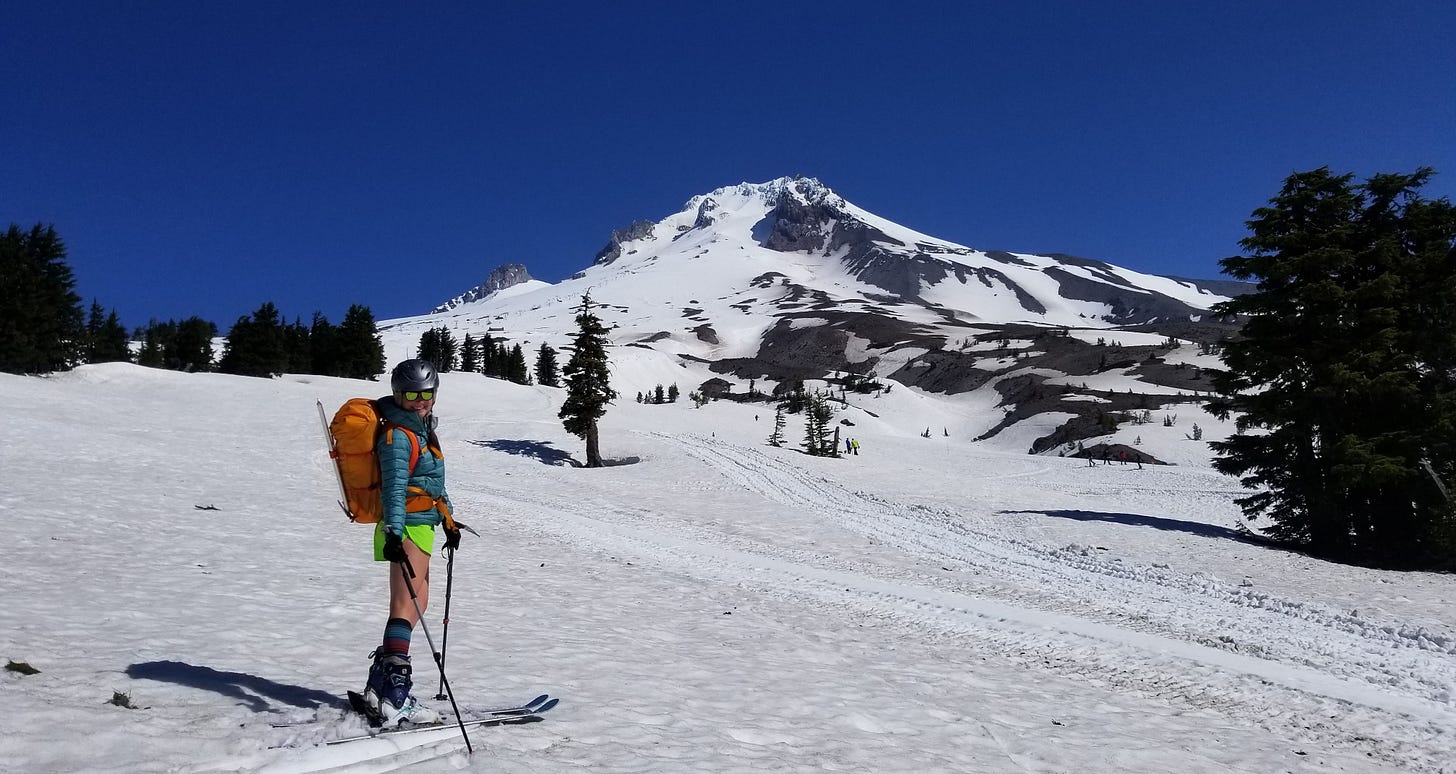The Tip-Top of Oregon
On the hurts-so-good sting of not being able to do that thing you want to do – yet.
“LOOK OUT! I-I-I-ICE!”
The bellowing warning came flying down the mountain – only slightly faster than the softball-sized chunks of ice that barreled after it.
A clump whizzed so close to my face that I could feel the breeze of its tailwind as it kept careening downhill. My skull was protected by a smoky grey ski helmet, but I was very aware that many inches of my body remained vulnerable to warp speed ice fall.
My heartrate jacked up several dozen beats as I glanced up at the steep slope – it was clear that anything else that fell from above, would also tumble in a very fast and furious manner. A glance down do didn’t do much to calm me – the icy white mountainside plummeted into a sulfur-piping fumarole below and all I could see was my body as the ice, falling fast and furious for hundreds of feet before getting gobbled up by a volcanic gas crack.
We were attempting to summit Mount Hood, Oregon’s tallest volcano, but we were running into some issues, namely the fact that the warming ice could travel much, much faster than I could. The burning mid-morning sun was starting to unleash bits of the snow-smothered summit as the mountain struggled to take the heat.
“Can you pick up the pace at all?” my friend Eli asked me. His tone was a compassionate acknowledgement of what we both knew: I really couldn’t.
“We’re losing our window to summit,” he said, his voice sullen. We’d started climbing at 1am in an attempt to beat the heat, but my pace had slowed once we’d reached the more consequential terrain and now it was looking like I had a decision to make, but there was only one right answer: to turn around and bail on my summit attempt.
It was my first time attempting to summit Hood, and I’d known that it would test my limits. I’d slept exactly zero seconds the night before while I stressed about whether I could keep up with my friends, whether I would fall down the mountain faster than melting ice – whether I would fail.
The tip-top layer of Mount Hood is more technical and more exposed than most other mountains I’d climbed at the time. And I have a fraught relationship with exposure. We’re working on getting more comfortable with each other, but I struggle to trust it. Every time I’ve traveled through terrain that is very steep and that hovers over ground that would not be very kind to a falling body, I want to slow things down. Take our time getting to know each other.
I’ve joked that my mountaineering trail name should be “Triple Rubber Halnon,” – a nod to the extreme caution I exercise while moving through exposed terrain. I usually resort to very slow and methodical movements when the cost of a fall might be a broken limb or two – or worse.
That was why I was moving slower than a three-legged tortoise on the final push up Mount Hood. I was kicking my crampon into the icy slope with determined vigilance – making sure the sharp spikes strapped to my ski boots were 1000 percent connected with the frozen ground before trusting my next step forward. Like buckling a seat belt and giving the strap a few dozen yanks just to make sure it’s locked into place before driving.
I had watched with envy and awe as my two companions flew up the steepest section of the mountain with immense comfort on the dicey stretch of the climb. I felt very aware of my inferior skills and strength as I lagged behind them despite trying my very best. Each slow step left me dripping in feelings of weakness and inadequacy.
“I’ll turn around here,” I told Eli, trying to hold in my emotions until I was alone. “You guys should definitely summit. I’ll wait down at Hogsback.”
“I think that’s the right decision,” he said. “But I’m sorry to leave you. I wish you could keep going with us.”
How much I wished I could keep going with my friends crushed me like a two-ton anvil. Instead, I started a dejected stumble back down to a flatter part of the mountain where I could wait for them.
My downclimb turned into a walk-of-shame as I watched other climbers pass me in both directions – those moving fast enough to keep pushing toward the summit – and those coming back down from their victorious rendezvous on the top of Oregon. I gripped my ice axe tighter as I nervously side-stepped down the mountain, feeling silly for how scared I was on terrain that wasn’t an issue for all of the stronger climbers around me.
When I reached the snowy plateau below, I looked up at the dramatic spine of the mountain – watching dozens of people do what I could not. Each Gore-Tex covered body was a billboard shouting out my personal failure. Each one a taunting advertisement of the disappointing gap between where I was and where I wanted to be.
***
There’s a run that I went on a several years ago that I think about a lot - and I thought about again later that day on Mount Hood.
It was a few months after I moved to Oregon and a few of my new running friends invited me to join them for a long run through some Cascade foothills. I’d just started running and racing on trails and I wanted to chase more and more and more of all of it: the 100 miler belt buckle, the big loops around the big volcanos in the Pacific Northwest, the coveted Western States finish. I was enamored by the possibility of tackling all of the huge, exciting, and terrifying goals that trail running offers and didn’t hesitate to accept an invitation to do more of this thing I wanted to do.
On this early January day, we trekked 20-something miles up and down the forested trails that climb up and down some of the foothills that sit outside of Eugene. “We” is a generous pronoun to use as I did not spend very many miles running in the vicinity of my friends. I was wheezing like a 12-pack-a-day smoker on the climbs and watching these friends disappear from sight within 12 steps of every break during our run “together.”
As I was struggling to keep pace with them for a single step uphill, I was haunted by the idea that we were just in the “foothills,” which sounds like such a dainty kind of terrain! A cute baby cousin to the real mountains – the dramatic volcanos that are stoic fixtures on the Oregon landscape.
As I battled my way up each climb, I couldn’t stop thinking about how pathetic it was that I couldn’t even handle these dinky little bumps in the ground when I wanted to run much bigger things through much larger mountains.
I ended the run tired, defeated, and feeling like a humpback whale had a better chance of hacking it as a trail runner.
When I got into my friend Jason’s car for the short drive back to town – my disappointment was as obvious as a root canal. I slumped forward, uncharacteristically quiet as we pulled away from the trailhead.
Jason, a therapist-in-training, turned to me and asked if I was okay.
“I just feel shitty that I couldn’t keep up and that the run let me feeling like an ant smushed into my muddy shoe,” I confessed, with a dramatic gesture toward my filthy tread.
“Emily, those were mountains we were running up,” he reminded me. His tone one you might use to coax a toddle out of an irrational tantrum. “It’s okay if it was hard! This was hard for me too when I started running out here. This is how it works!”
I don’t know what I expected that day – that I would just magically be able to do this big thing I wanted to do. Like deciding to start writing and thinking a High Wizard of Publishing would award me a book deal after my very first draft of an essay.
I just know that on that day, I felt wholly disappointed and defeated by where I was at with trail running – because it felt several galaxies from where I wanted to be.
Jason’s compassionate reassurance didn’t make me feel immediately better. I spent most of our drive back to Eugene calling myself a loser and picturing myself as a smushed ant incapable of crawling across the start line at a 100 miler.
But I did eventually realize I was being a bit dramatic and managed to find a little compassion for myself and where I was at. And, most importantly, so much determination and excitement to keep going, despite feeling so overwhelmed by how far I had to go.
Because isn’t that something we all love about running?
That it lets us slowly make our way across all of the galaxies that exist between where we are and where we want to go, if we keep showing up and working hard and having faith in what we might be able to do. It offers us a space to push through our searing doubts and our devastating failures and our overwhelming insecurities and see what happens if we keep going.
Thank god I didn’t let that disheartening run stomp all over my excitement for trail running and my desire to do some real big things in the sport. Or let those feelings of inadequacy deter me from taking the next step forward.
Because obviously, my story with trail running did not end after this one defeating run. (Nor did my story with defeating runs end with this one defeating run.)
I’ve gone on to do so many trail running things that I never would have imagined possible after that crushing run through the foothills: multiple 100 milers through way more mountainous terrain, running some of the biggest loops around the biggest volcanos all by myself, running 460 miles across the Oregon PCT faster than any other human.
I’ve kept searching for my limits through running and I love that I haven’t found them yet. And haven’t let the disappointment or failures along the way define them for me.
That day has popped into my head so many times as I keep pursuing harder and harder goals with trail running. It’s a little post-it note on my mental mirror to keep going – even when the dream destination seems impossibly far away.
***
As I sat on that snowy plateau after bailing on my summit hopes, I felt as rotten as a 33 day-old banana.
But at some point after I was done calling myself a loser, I started to recognize my seeping disappointment as a familiar feeling – the same sting I’d felt when I huffed and puffed my way through that foothill run years ago.
That disappointment in how far I was from where I wanted to go.
I remembered that the winter before, I’d sworn off the idea of ever climbing Mount Hood.
“It’s too steep at the top,” I told a friend. “It’s not something I want to do. I don’t care if I never summit Mount Hood.”
But that was a lie. I did care about climbing Mount Hood. I just didn’t know if I could do it.
I was too overwhelmed by the gap between me and the tip-top of the summit – and all of the adrenaline-pumping, palm-sweating steps I’d have to take along the way. And so I tried to convince myself I didn’t want it.
But, the reality was that I wanted to tackle bigger and scarier objectives on the mountains around the Pacific Northwest. I wanted those endeavors to offer me the same things I’ve loved about running: a chance to see what I can do. To chase goals that might not be possible. To fail. To go back and try again and maybe get a little closer and a lot more excited. Or maybe blow right by that thing that was once unthinkable. Like going from struggling to run 20 miles in the foothills to running across an entire state in record time.
The sting of bailing on Mount Hood burned deep, but when I recognized that sting as one I was intimately familiar with through running, I started to get excited about that burns-so-good sensation. And appreciated that I was exactly where I needed to be: trying to take the next uneasy, terrifying, overwhelming step toward the next galaxy.
I felt disappointment punching me in the gut, and I also felt the possibility that existed beyond it.
I looked back up at the icy summit of the mountain looming above me. Thinking about how maybe I’ll never stand on the tip-top of Oregon. Maybe I’ll never be strong enough to get there. Maybe I’ll never find the courage to take those final scary steps.
But maybe I will get there - and then keep going. And I knew I would come back to find out.
Share or subscribe to Trail Mix to send more stories about life, running, and the outdoors to more inboxes.












Thank you so much for sharing your struggles and insights, I loved reading your take on themes that resonate in so many other areas of life. I've been learning how to fail better over the past year, and your words really spoke to me. Keep up the amazing work!
This spoke so deeply to me. I’ve taken on some big challenges this year, and come up short on completion. Saying that I t has been hard to swallow is a gross understatement. Thank you for the reminder that pushing up against my edge of impossible is exactly the kind of runner I want to remain. Cheers to the next adventure!